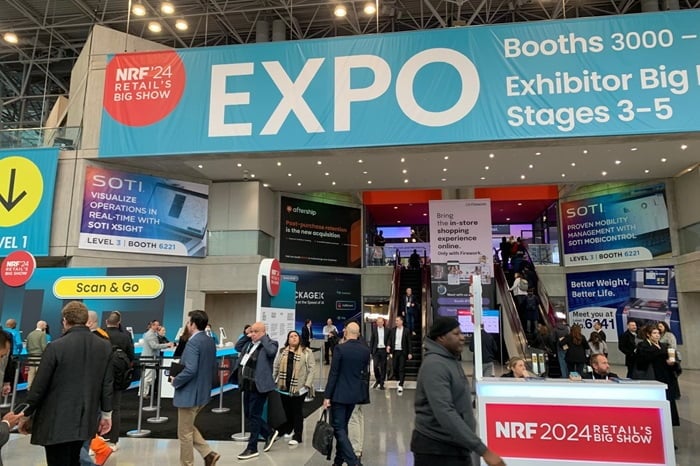NRF review – no escaping AI
Artificial intelligence (AI) was the only talk in town when senior retailers and technology providers descended on New York City for the annual Retail’s Big Show, organised by the National Retail Federation (NRF), where the latest technology innovations are showcased.
The 40,000 people attending from 104 countries representing 6,200 brands at this year’s event were inundated with solutions highlighting various AI capabilities. Pretty much every technology solution present was seemingly driven by AI.
Augmenting human activity
Marc Benioff, CEO at Salesforce, is well aware of the hype built around the technology and warns: “If it does not improve us, or the world, then we lose the plot with AI.” Instead he is very much an advocate for its use to augment existing activities and personnel. He cites its use by Gucci in its call centre: “It has taken the group up to another level. By applying AI to agents who were dealing with issues the system has augmented their activities and is making them better.”
This is also the thinking of Clodagh Moriarty, chief retail and technology officer at Sainsbury’s, who says: “We’re a people centric business. We’re bringing people and technology together. I think about it as being an ‘and’ and not an ‘or’. We combine AI with the teams in Sainsbury’s.”
At the front end of the business in its stores the check-out has been recognised as a big opportunity for AI. The company has been rolling out smart scales that can identify products, through a partnership with NCR, which “has transformed the front end. “We’re deploying AI to increase the speed but also improve the overall customer experience,” says Moriarty.
David Kimbell, CEO of Ulta Beauty, agrees: “Innovation starts with the human connection. Despite all the technology, there’s a strong desire to connect on human terms. AI can complement the human. We’ve virtual chat tools and AI can do guest services to bring more data, more personalisation and a more human experience to this.”
Robotics improving consistency
The company has utilised the capabilities of the new technology to deliver virtual try-on solutions, and more personal communications through its loyalty programme and app, which represents 50% of its e-commerce revenues. There are also elements of robotics coming into play at the company with a robotic eyelash extension service that automates the process making it faster and more consistent. Also, in the trial stage, is an automated manicure service. “In-store and at home [via digital] we’re investing in beauty technology. We’re very excited.”
Robotics was very much playing second fiddle to AI at this year’s NRF with limited representation compared with what had been seen in previous years. Among the solutions present was a humanoid robot, Apollo, from Apptronik that was being showcased as a solution that is very much multi-functional rather than being limited to undertaking a specific repetitive task.
Jeff Cardenas, co-founder & CEO of Apptronik, says: “Many robots are very limited. With the Apollo it can do different things – in the warehouse moving boxes and totes – and also move from the back of house to the front end. As the technology improves then there will be more complex tasks it can achieve. With labour shortages it’s not about savings from robots, it’s about getting tasks done.”
Focus on customer experience
Very much focusing on the front end to boost the customer experience is Chris Rupp, chief customer officer at Victoria’s Secret, who says the company is using AI to improve the digital experience by integrating video online. “The digital experience can be quite flat. To bring in more physical/emotional things is very important. We’re using short-form video on the website that acts as a two-way tool. We’re looking to match this to the [individual] customer through bringing the data to bear. We’re just in the opening innings here. The conversion in-store is seven-times that online because in-store there is a conversation. What if we could convert a few more people by using technology to bring conversation to the online experience?”
There was also a focus on empowering employees through AI at NRF this year. Sainsbury’s has been experimenting with Microsoft’s Copilot – an AI companion – to improve the efficiency of meetings as it enables the interrogation of data from within the business and helps determine follow-up steps. Moriarty can see the value in ultimately having this capability in “colleagues’ pockets to give each of them this enterprise knowledge”. “Data has the key role, whether that is at the depot or back room or in-store. We can bleed a little AI into all stages,” she says.
Jonas Stillman, senior director of omni-channel operations at US-based Home Depot, highlights how the company reviewed all store processes and concluded that technology placed in the hands of all employees would enable the company to massively improve efficiency with its omni-channel order fulfilment – particularly its BOPIS (buy online, pick-up in-store) capabilities.
Every single store associate – numbering 7,000 – has been given a digital device that enables them to deliver on the company’s 20-minute pick-up service in-store for goods ordered online. “The mobile device has become the cornerstone of the operation and enables store staff to spend more time with customers,” he says.
Improving inventory accuracy
As BOPIS has become an increasingly important feature of the post-pandemic retail landscape for shoppers Dean Frew, group CTO at SML, says it is proving to be the key driver of RFID adoption by retailers as it enables them to dramatically improve the accuracy of their tracking of inventory. Using just the traditional methods in the supply chain means retailers typically have between 55-75% inventory accuracy, which has led to issues.
“Retailers can’t live with the cancel rates of orders because of stock not being available for BOPIS orders. They either beef up their inventory [with more stock held as a buffer] or they cancel the orders. For some retailers it can be 50% cancel rates,” he says. For a growing number of retailers the alternative is investing in RFID.
The post-pandemic environment has also seen major change at FedEx, according to Raj Subramaniam, CEO of FedEx, who says that in 2016 as much as 75% of its parcel stops were business related whereas today this has been turned on its head and 75% of stops are now for consumer parcels. To address the dramatic changes in the marketplace the company used NRF for the launch of its end-to-end e-commerce platform, fdx, for retailers to use as a single source of truth of their supply chain. “This offers a seamless, personalised shopping experience for customers. It provides smarter supply chains for everyone,” he says.
Weather management
The weather’s impact on the supply chain can be dramatic and the use of technology can enable retailers to predict demand and adjust their supply chain accordingly. Aaron Cano, SVP of analytics & marketing operations at Fresh Direct, works with Planalytics to deal with weather-driven demand (WDD): “It has a huge impact on demand. If it snows two inches or rains for five days then what’s the impact? Demand can increase 20% on Thursday and Friday before rain is forecast. If we know the forecast a few days out then we can amend the supply chain.”
He also highlights how staffing levels are impacted by the weather from people not turning up for work so it is sensible to gear up the staffing levels beforehand. “There is ripple effect on the business from the weather. With a forecast we can automate, through machine learning, changes to the supply chain,” says Cano.
Manipulation of the supply chain – by impacting demand – can be achieved by adopting intelligent pricing capabilities. Partap Sandhu, head of pricing at Norway-based supermarket REMA 1000, says the company uses a dynamic pricing solution from Revionics, which currently enables it to change prices to maintain its position as the cheapest supermarket in Norway.
It undertakes price comparison scanning at its competitors and from this it identifies where it is not cheapest and adjusts its prices accordingly on the electronic shelf-edge labels (ESLs) that it has in all its 675 stores. The whole process takes only 15 minutes and it typically undertakes 100 price changes per day in each store.














